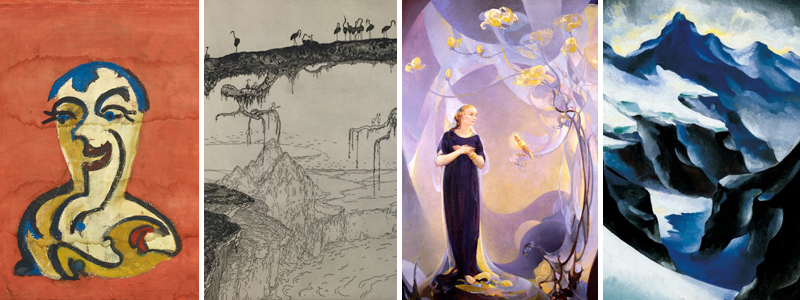The Pursuit of Abstraction, October 7, 2016–April 16, 2017
A rare tapestry by Ernst Ludwig Kirchner anchors exhibition of fine and decorative art dating 1900–1950
This October, The Wolfsonian–Florida International University examines cultural responses to spiritual crises of the modern age in The Pursuit of Abstraction, an exhibition of works by early twentieth-century artists searching for meaning beyond the boundaries of scientific reasoning and rationality. Drawn from the museum’s permanent collection, The Jeri L. Wolfson Collection, and The Mitchell Wolfson, Jr. Collection of Decorative and Propaganda Arts Promised Gift, the exhibition features paintings, prints, sculpture, and decorative art—including one of the few theater curtains ever created by renowned German expressionist Ernst Ludwig Kirchner, innovatively displayed for a full front-and-back view of the overpainted canvas to reveal two different moments in the life of the work.
The Pursuit of Abstraction will be on view from October 7, 2016 through April 16, 2017, and paired with an online content platform with images, essays, and other supplementary material. In addition to Kirchner, featured artists include Mabel Alvarez, Wenzel Hablik, Victor Karl Hammer, Gertrude Hermes, Agnes Pelton, Henry van de Velde, and Ida O’Keeffe, younger sister of Georgia O’Keeffe.
“As modernization eroded mysticism, artists experimented with new forms of expression to reintroduce mystery into everyday life,” explained Wolfsonian curator Matthew Abess, who organized the exhibition. “This spiritual counterculture sought to reenchant the world by way of aesthetic experience.”
Focusing on works produced between 1900 and 1950, the exhibition takes a close look at North American and European artists that turned to abstract thought, feeling, and form as counterpoints to the concrete realities and alienation of modern life. As the world around them became increasingly secular and urbanized, these makers imagined new expressions of spiritual awareness that drew inspiration from a wide variety of sources: philosophy, mythology, psychology, poetry, and ideologies ranging from established religious doctrines (Christianity and Buddhism) to newer, lesser-known schools of thought (Theosophy and Anthroposophy). Despite this diversity, common threads are found in an emphasis on transformation, allusion to forces within and forces beyond, and the depiction of otherworldly figures.
Of the roughly 80 objects on view, highlights include:
- Kirchner’s massive, 7×16-ft theater curtain from the 1920s, installed at The Wolfsonian to reveal both the later overpainting for a 1931 performance and the original composition of a Dionysian/cosmic fantasy scene, which remains visible as a mirror image on the reverse;
- Energia sociale [Social Energy] (1920), a painting by Italian artist Sexto Canegallo that expresses spiritual harmony through a synthesis of color and line;
- Abstraction (1926–38), a sensuous painting of mountain summits and valleys by mountaineer Georgia Engelhard, whose developed her signature style alongside her aunt and frequent companion, Georgia O’Keeffe;
- Silent Places (c. 1929), a colorful, meditative dreamscape by Mabel Alvarez;
- Agnes Pelton’s luminous painting Radiance (c. 1929), which seeks to render light as a manifestation of inner being;
- An angular desk with bookcase (c. 1930) by designer Camillo Cerri that evokes the Anthroposophical belief that prismatic, elemental forms could reveal spiritual mysteries;
- The Stokowski Symphony (1934), a tonal portrait of composer Leopold Stokowski by partially deaf artist Dorothy Brett, painted in soft pastels to convey the mystery of musical experience; and
- A selection of prints from Wenzel Hablik’s Schaffende Kräfte [Creative Forces] portfolio (1942), portraying a visionary, crystalline utopia.
“It is commonly said, ‘art feeds the soul,’” stated Tim Rodgers, Wolfsonian director. “This peek inside the vaults of The Wolfsonian and the unique collections of Jeri and Micky Wolfson provides a feast for viewers, inviting them on a journey into an abstracted world of feeling and sensation, color and light.”

